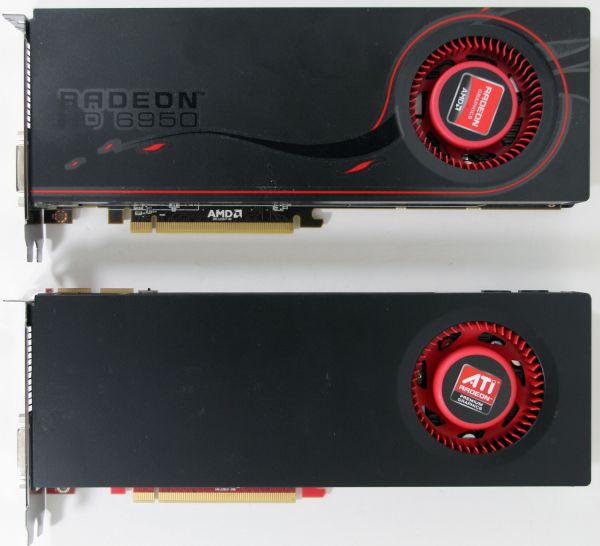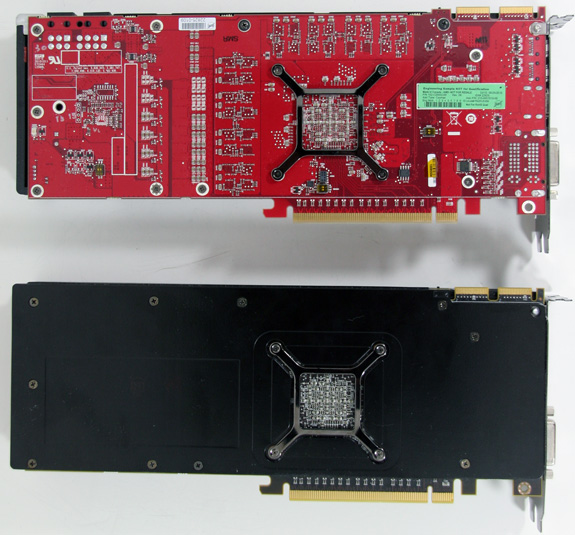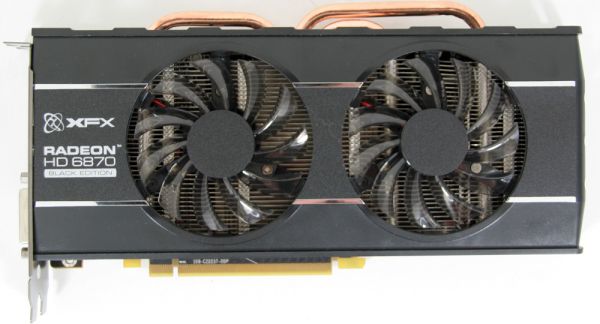AMD’s GTX 560 Ti Counter-Offensive: Radeon HD 6950 1GB & XFX’s Radeon HD 6870 Black Edition
by Ryan Smith on January 25, 2011 12:20 PM ESTMeet The Radeon HD 6950 1GB and XFX Radeon HD 6870 Black Edition
We’ll start our look at today’s cards with the headliner: AMD’s Radeon HD 6950 1GB. As we’ve previously established our 6950 is an engineering sample – perhaps an early one – so there’s not much to look at. Save for the kind of cosmetic defects you’d expect on an engineering sample, it’s for all practical purposes identical to the production 6950 2GB, and that’s intentional. AMD set out to make the 6950 1GB identical to the 6950 2GB other than the use of lower capacity GDDR5 chips, and this is what they have accomplished.

Top: 6950 2GB. Bottom: 6950 1GB Engineering Sample

Top: 6950 1GB Engineering Sample. Bottom: 6950 2GB
Since producing a 1GB card involves little more than replacing 2Gb memory chips with 1Gb memory chips, the true design innovations are going to come from AMD’s partners. Sapphire already has a 6950 1GB out with a custom cooler, and as AMD’s other partners get situated with 1GB cards we expect to see much of the same with them.
One item worth noting is that because our card is based on the reference design, it includes the BIOS switch at the top of the card. This means reference-based 1GB cards are going to have the same BIOS failsafe in them – however suitable BIOSes for the unlockers among you are another matter. Without some BIOS hacking (and possibly more), existing 6970 BIOSes are unsuitable as they’re meant for 2GB cards. Until such a time comes where a 6970 1GB BIOS can be developed, the 6950 1GB is not going to be a good card for unlocking. For the time being unlockers are going to want to stick to 2GB cards.
The Radeon HD 6950 1GB is launching with an MSRP of $259. At this time you can find reference-style 2GB cards for as little as $269, making the 1GB cards a rather simple $10 trade-off if you don’t mind mail-in rebates.
XFX Radeon HD 6870 Black Edition
Our second card of the day is XFX’s 2nd generation Radeon HD 6870 Black Edition (687A-ZDBC), the card that AMD originally proposed as the GTX 560 Ti’s competitor. Clocked at 940MHz core and 1150MHz (4.6Gbps data rate) memory, it runs at 40Mhz (4%) core and a 100MHz (9%) memory over the reference 6870. Overall this is a mild overclock, particularly as the 6870 is core-bound as opposed to memory-bound most of the time.
With such a mild overclock we had little reason to pay attention to the card, particularly once we completed our GTX 560 Ti benchmarking and saw that it was 10-20% faster than the stock-clocked 6870. Indeed it wasn’t until we tested the card that we saw something that grabbed our attention. Or perhaps I should say heard.
At the risk of spoiling the rest of our article, this card is for all practical purposes silent. At idle it’s only as loud as the noise floor of our GPU testbed, and at load – even under Furmark – it’s the same story. We measured 41.4dB at both idle and load, making it the quietest actively cooled mid-range card we have ever tested in our existing rig. Even the remarkably quiet GTX 460 can’t hold its ground to the 6870 Black Edition, it’s that quiet.
So what’s XFX’s secret? It’s much the same story as with the GTX 460. While the 6870 reference design uses a blower XFX is using an open-air cooler, specifically a double-fan cooler with 3 copper heatpipes that’s very similar to MSI’s Twin Frozor and Gigabyte’s Super Overclock cooler. Open-air coolers are already capable of being much quieter than blowers, and when done correctly a double-fan arrangement can be quieter than driving a single fan at higher speeds. Combining this highly effective cooler with the 6870’s Black Edition’s low TDP (~160W) results in a very quiet card that by all indications cannot be beaten at this point in time.
Rounding out the package, there are no real meaningful extras to discuss. Aside from some trinkets (stickers, case badges, etc), the only other piece of hardware in the box is a short CrossFire bridge. XFX has kept it simple: the only things that really matter are the card and XFX’s lifetime warranty.
The Radeon HD 6870 Black Edition doesn’t have a set MSRP, but it’s currently available for around $229 with a mail-in rebate, making it roughly $10 more expensive than a stock-clocked card. Or compared to XFX’s lineup, the non-Black Edition version of this card is a mere $4 less at $225; so you’re looking at a $4 factory overclock and $6 for a supurb custom cooler.












111 Comments
View All Comments
GeorgeH - Tuesday, January 25, 2011 - link
There is no bias at Anandtech, only well documented arguments and conclusions that you're free to disagree with. If you want to abandon one of the best tech review sites on the planet in favor of one that panders to your personal delusions about the fuzziness of a multinational corporation, knock yourself out.prdola0 - Tuesday, January 25, 2011 - link
I do not want to invalidate the arguments and facts in the article. No problem there. Just that they didn't include the OCed GTX560, which is going to be a major player.sinPiEqualsZero - Tuesday, January 25, 2011 - link
Find me a factory-overclocked GTX 560 that is currently available in the market. Then we can have that discussion. Anandtech is testing what is currently available - something I'm not sure you understand. All of these reviews are snapshots of a moment in time.My searching shows one as "OC" on newegg, but no details about the core clock. That isn't a sign that the site is biased, it's called reality.
prdola0 - Tuesday, January 25, 2011 - link
There are two already available (in Europe anyway): one from Asus and one from Gigabyte.omelet - Wednesday, January 26, 2011 - link
They're working on a review for the overclocked card. I don't think they've ever released benchmarks for factory overclocks the same day that the card comes out, at least not in recent history, so it's not unexpected for them not to have included overclocked GTX 560 data yet. Wait for the 560 overclocked article in a few days.Melted Rabbit - Tuesday, January 25, 2011 - link
The 850MHz GTX460 rarely ever in stock at online retailers during its lifespan, at times, the 810MHz GTX460 was even hard to find. The overclocked GTX460s that had even lower clocks were generally available. With these previous supply constraints in mind, why should any review site review another highly overclocked card like the 900MHz GTX560 Ti, when its predecessor was a low volume card created specifically to deceptively improve the perceived benchmarks and perceived value of the rest of the cards in its series?I have no issue with anandtech or other websites reviewing or including in reviews a 900MHz GTX560 if the variant is still readily available in four to six weeks. It would mean the card existed in reasonable quantities and was not just another Geforce 8800 Ultra card that showed up for the reviews and then was never actually in retail.
On the other hand, the 6870 Black is a modest overclock of the 6870 from AMD, who has not had and has no supply problems with the 6870 cards.
GeorgeH - Tuesday, January 25, 2011 - link
My personal experience is that EVGA's ~850MHz 460s have never impossible to find, although it has occasionally been difficult to find ones that weren't the less desirable external exhaust model. I've never had any difficulty finding ~810MHz cards.I didn't do much shopping around Christmas/New Years, though, so my experiences might not be representative of the average.
GeorgeH - Tuesday, January 25, 2011 - link
GTX 560 cards are going to be a major player? Really? You know this how? Because your talking points memo from Nvidia marketing told you so?If you honestly care about 560 OC results, here's what you can say - "Hey Ryan, will you be getting a chance to test any overclocked 560's soon? How do you think they will perform?"
Instead, here's what you went with - "OMG!! They didn't include every freaking card on the planet! BIAS! Sweet baby Jesus, I weep for the Anandtech that was!"
The only thing really missing from this article was the inclusion of an overclocked 460, which from previous benchmarks should be very competitive for $50 less. Unfortunately the ridiculous shitstorm from the last time it was included means we can't have nice things anymore.
prdola0 - Tuesday, January 25, 2011 - link
The Gigabyte and Asus OCed cards were available even before stock clocked cards. How is that in any way "temporary" or "uninterresting"? You are trying to downplay it really hard, but for apples-to-apples comparison, there should be the overclocked competition as well.GeorgeH - Tuesday, January 25, 2011 - link
Quotation marks - they do not mean what you think they mean. Nowhere on this page has anyone used either the words "temporary" or "uninteresting", nor any synonyms that I can see.No one is downplaying anything other than your ridiculous claim that AT and Ryan are biased because in two weeks they didn't manage to benchmark and write up every single card in the universe that might be relevant to your interests.